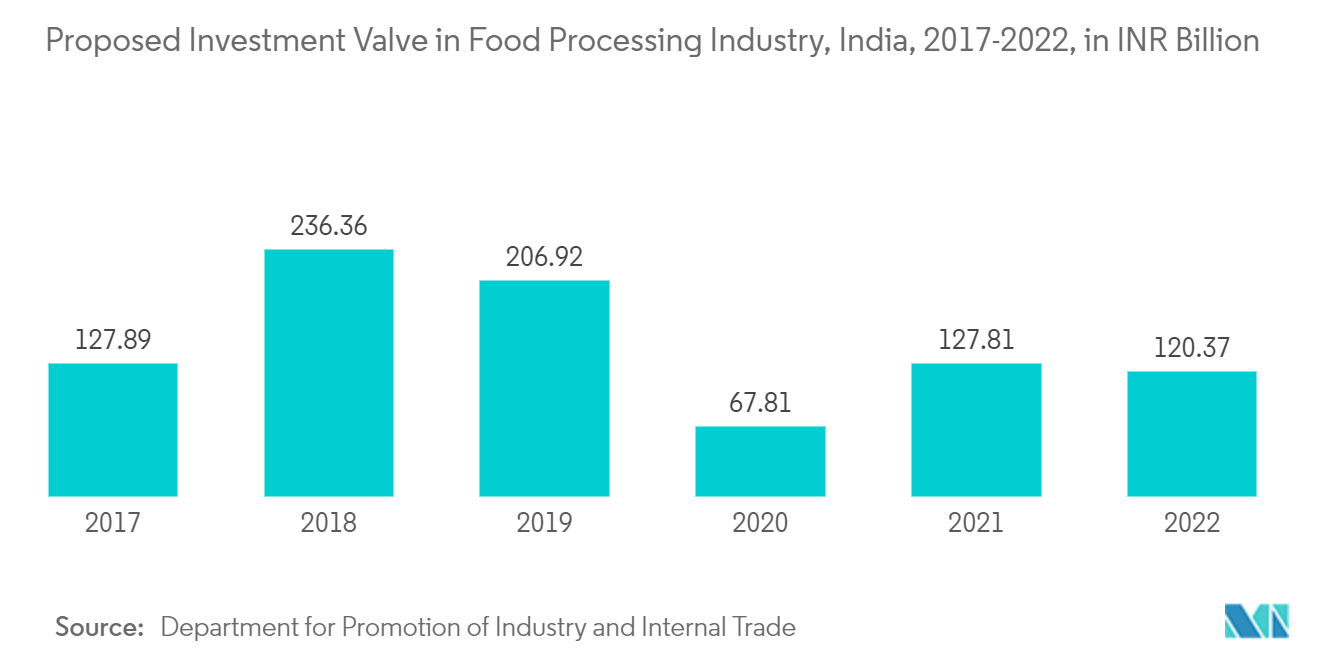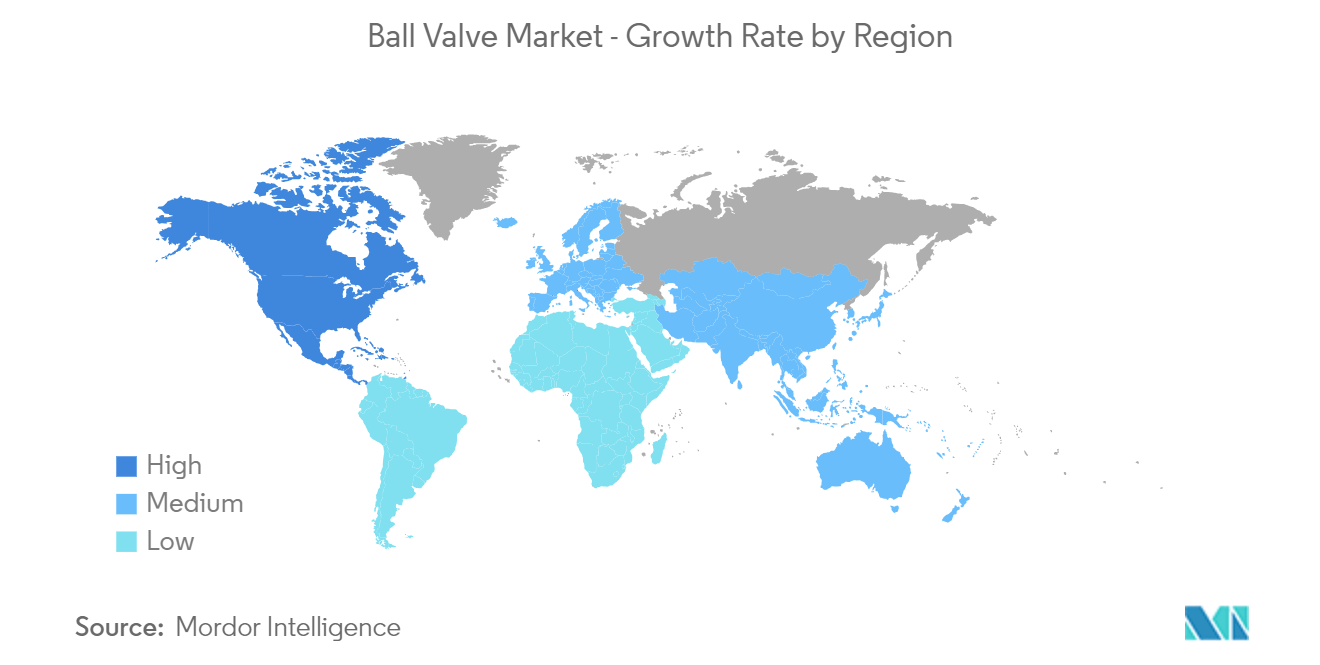Market Trends of Ball Valve Industry
Food Processing Industry Expected to Have Significant Applications
- The food processing industry is a notable sector where ball valves find significant application. The process of product fillings necessitates the maintenance of a regulated flow, making ball valves an essential component. The valves employed in the industry are of two types: those that come in direct contact with the material and those used in utility services such as water and steam. In both cases, the valves must comply with several industry regulations, particularly those that come in contact with food material. This presents a considerable challenge for manufacturers to obtain regulatory approvals, requiring them to design valves that meet stringent industry standards.
- Ball valves are highly efficient in controlling and maintaining high volume, temperature, and pressure. In the food and beverage sector, sanitary ball valves are utilized to connect and regulate conveyance pipes, ensuring the purity, stability, and quality of fluids during transport due to their stainless steel construction. Sanitary valves are also easy to disinfect and clean, promoting hygiene. The market is expected to grow due to continuous product launches by various vendors.
- For instance, in November 2022, Valworx, a producer of actuated valves and equipment controls, recently introduced a novel range of hygienic ball valves suitable for deployment in the food and beverage manufacturing sector. These ball valves are equipped with a conspicuous position indicator and are compatible with Namur and ISO mountings. The valves are obtainable in two- and three-way configurations and available in various sizes ranging from 0.5 to 4 inches. The new line of valves conforms to the FDA, USDA, and 3-A standards.
- Stainless steel is increasingly recognized as a crucial material due to its extensive resistance to corrosion, a significant concern in the food processing sector. These valves have also demonstrated exceptional durability when exposed to more aggressive water compositions, offering notable advantages to food processing plants. Moreover, stainless steel valves possess a higher pressure rating compared to alternative materials like brass. For instance, a typical 1-inch brass ball valve may have a pressure rating of 600 PSI, whereas a standard stainless steel ball valve of the same size would likely have a pressure rating of 1000 PSI. This characteristic renders them particularly suitable for high-pressure applications within the food processing industry.
- The growing urbanization rate across various parts of the world significantly enhances the demand for packaged food. Changing lifestyles, especially in urban areas, also contribute to the ever-increasing demand for packaged and processed foods. To ensure food security and achieve self-sufficiency goals, various countries are making efforts such as making regulatory changes and developing special economic zones to develop food processing industries; for instance, in June 2022, USDA announced a fund of USD 375 million in support for meat and poultry processing plant projects in the United States. Such factors will create the demand for the ball valves for their extensive usage in the food industry.
- A favorable scenario for the growth of the studied market has also been observed in other countries. The Department for Promotion of Industry and Internal Trade reported that the proposed investment in the food processing sector in India was valued at INR 120.37 billion (USD 1.47 billion) in 2022. Efforts are being taken to encourage investments across the entire value chain by the Indian Ministry of Food Processing Industries, including the implementation of the PLI scheme, which is expected to expand food processing capacity by nearly INR 30,000 crore (USD 3.6 billion) and create additional direct and indirect employment by the year 2026-27. Such initiatives are expected to offer significant opportunities for the ball valves.

North America is Expected to hold a Significant Market Share
- North America stands as a prominent market for ball valves, boasting substantial demand across diverse industries such as oil and gas, electricity, food and packaging, and chemicals. Both the United States and Canada exhibit immense demand, further fueled by the swift integration of industrial automation. The projected trend is expected to stimulate the market demand for ball valves in the region.
- North American area is witnessing a growing requirement for intelligent ball valves. Prominent regional industries are transitioning towards ball valves that incorporate processors and networking capabilities to complement advanced monitoring technology, which is coordinated through a central control station. The increased adoption of automation in process industries further reinforces this demand trend.
- The United States assumes a pivotal role in augmenting regional demand in contrast to Canada. The nation experiences a growing demand across nearly all end-user sectors, particularly in oil and gas, refining, and power generation. Higher energy consumption is the primary factor behind the higher demand across these sectors. For instance, according to EIA, total immediate energy consumption in the United States in 2022 was about 102.92 quadrillions Btu, of which petroleum consumption was about 31 percent.
- Furthermore, higher demand for oil & gas and other petroleum products also drives oil producers to increase their production and explore new oil extraction sites, which are expected to help the studied market grow further. For instance, in November 2022, the Canadian Association of Energy Contractors (CAOEC) announced that in 2023, it expects about 6,409 wells to be drilled in Canada, an approximately 15 percent increase from 2022.
- It is expected that new water treatment facilities will likely be set up in the region to feed the demand for ball valves as a result of an anticipated increase in regional population and increased water consumption across different sectors. A notable example is the recent announcement by New York State officials in September 2022, wherein they allocated over USD 232 million for water and sewer infrastructure projects in seven municipalities. The New York State Environmental Facilities Corporation granted funds and offered low-cost financing packages to facilitate water infrastructure initiatives with a cumulative expenditure exceeding USD 763 million. These investments in establishing treatment plants will inevitably augment the need for ball valves.
- Ball valves are utilized to regulate pressure and flow. Their leak-proof nature is a notable attribute that renders them highly advantageous, particularly in the chemical industry involving liquids. In July of 2022, BASF declared its final investment decision on a project worth USD 780 million, aimed at doubling the production capacity of its chemical manufacturing complex in Ascension Parish, Louisiana. The expansion project, which spans over seven years and represents a combined capital investment of over USD 1 billion, will enable the company In order to meet the growing demand for its products in a variety of sectors, such as construction, appliances, road haulage, and automobiles throughout North America.

